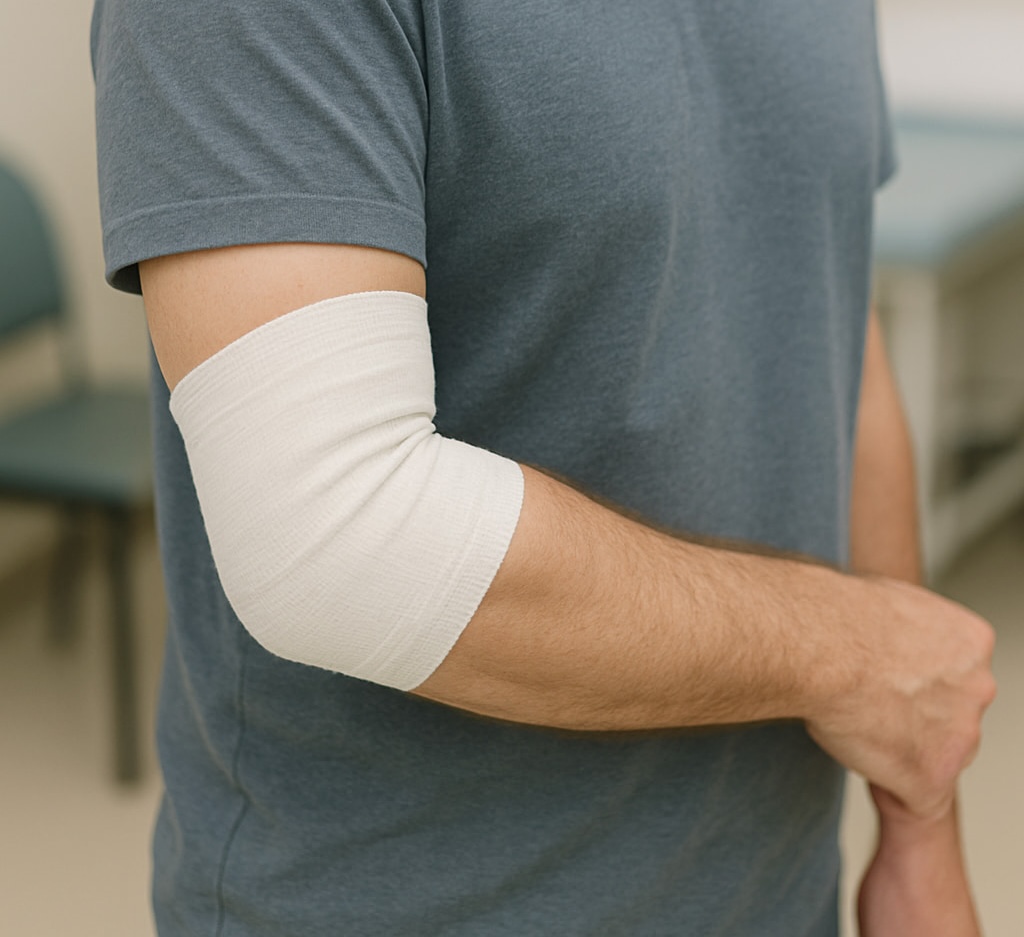See Also:
Rehabilitation Goals
- Protect the surgical site and allow healing
- Reduce pain and swelling
- Restore range of motion (ROM)
- Improve strength and function in the arm and hand
- Prevent recurrence of symptoms
Expected Recovery Time
| Milestone | Timeframe |
|---|---|
| Pain and swelling reduced | 1–3 weeks |
| Return of light hand use | 2–4 weeks |
| Near full range of motion | 4–6 weeks |
| Strengthening phase begins | 6–8 weeks |
| Return to full activities | 8–12 weeks |
| Full recovery in nerve function | Up to 6–12 months |
Phase 1: Early Post-op (0–2 weeks)
Goals
- Protect surgical site
- Control pain and swelling
- Begin gentle hand and wrist mobility
Instructions
- Keep the incision clean and dry
- Keep the elbow elevated above heart level to reduce swelling
- Apply cold packs for 10–15 minutes several times daily (avoid direct contact with skin)
- Avoid lifting, gripping, or pressure on the elbow
Exercises
- Finger and wrist range of motion: Flex and extend fingers and wrist 5–10 times every hour while awake
- Shoulder shrugs and circles to maintain shoulder mobility
- Elbow movement is usually limited at this stage—follow your surgeon’s instructions
Phase 2: Intermediate Recovery (2–6 weeks)
Goals
- Gradually increase elbow range of motion
- Resume light daily activities
- Continue pain and swelling management
Instructions
- Stitches are usually removed around 10–14 days post-op
- Begin gentle elbow flexion and extension as advised
- Avoid lifting more than 0.5–1 kg
- Use the hand for light activities only (e.g., typing, eating)
Exercises
- Elbow flexion and extension within comfort range (3–5 sets of 10 reps per day)
- Wrist and forearm strengthening with light resistance (e.g., squeezing a soft ball)
- Nerve gliding exercises as instructed by your therapist
Phase 3: Strengthening Phase (6–10 weeks)
Goals
- Restore full range of motion
- Begin strengthening exercises
- Resume moderate activity levels
Instructions
- Avoid high-impact activities or heavy lifting
- Resume work activities if they are light or sedentary
- Continue regular exercises to promote circulation and strength
Exercises
- Full elbow range of motion stretching
- Progressive resistance training for the hand, wrist, and forearm
- Ulnar nerve gliding exercises as tolerated
- Grip strengthening using therapy putty or hand exercisers
Phase 4: Return to Activity (10–12+ weeks)
Goals
- Return to full function
- Resume previous work or recreational activities
- Maintain strength and flexibility
Instructions
- Gradually return to activities requiring repetitive elbow use
- Avoid prolonged elbow flexion (e.g., resting elbows on hard surfaces)
Exercises
- Sport- or job-specific functional training
- Continued strengthening and flexibility routine
- Monitor for recurrence of symptoms during increased activity
When to Contact Your Surgeon
- Signs of infection (increased redness, warmth, swelling, drainage, or fever over 38°C)
- Persistent or worsening pain not relieved by medication
- Numbness or tingling that worsens after surgery
- Loss of movement or strength in the hand or arm
- Opening of the incision or unusual bleeding
Disclaimer:
This is a general guideline. Your physiotherapist, hand therapist or Dr Lambers may adjust the protocol based on your specific condition and progress.
